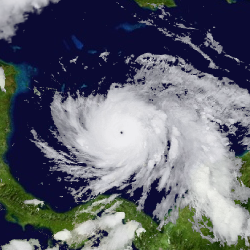| Category 5 major hurricane (SSHWS/NWS) | |
 | |
| Formed | November 15, 2021 |
|---|---|
| Dissipated | November 27, 2021 |
| Highest winds | 1-minute sustained: 185 mph (295 km/h) |
| Lowest pressure | 898 mbar (hPa); 26.52 inHg |
| Fatalities | 57 |
| Damage | $9.4 billion (2021 USD) |
| Areas affected | Venezuela, Colombia, Jamaica, Honduras, Belize, El Salvador, Guatemala |
| Part of the 2021 North Atlantic hurricane season | |
Hurricane Deshawn was a destructive category 5 hurricane that stalled over Jamaica and was one of only two November category 5 hurricanes ever recorded. Deshawn was the twenty-seventh tropical or subtropical cyclone, twenty-fifth named storm, thirteenth hurricane and seventh major hurricane of the 2021 North Atlantic hurricane season. The hurricane became the strongest of the season after rapidly intensifying at a near record-breaking pace in the southwestern Caribbean Sea, before it made landfall and stalled in Jamaica, where it produced massive damage. The cyclone had weakened during this time, but later started moving west-southwest and intensified again. It made a second landfall in Honduras at its secondary peak intensity and crossed into the Eastern Pacific basin, where unfavorable conditions quickly caused Deshawn to dissipate.
Deshawn caused damages along much of the western Caribbean coast, but Jamaica experienced the worst of the storm. Multiple newspapers called the hurricane the worst to have ever struck the island. In total damages from the storm amounted to $9.4 billion, and 57 deaths were also reported.
Meteorological History[]

Map plotting the storm's track and intensity, according to the Saffir–Simpson scale
Tropical storm (39–54 mph, 63–87 km/h)
Category 1 (74–95 mph, 119–153 km/h)
Category 2 (96–110 mph, 154–177 km/h)
Category 3 (111–129 mph, 178–208 km/h)
Category 4 (130–156 mph, 209–251 km/h)
Category 5 (≥157 mph, ≥252 km/h)
A westward moving tropical wave formed over Venezuela at 06:00 UTC on November 12. The NHC immediately started tracking this wave due to its expected presence in extremely favorable conditions in a couple of days. As it passed the mountains of northern Colombia, a circulation quickly closed off and intensified. The system moved out into the Caribbean Sea at 18:00 UTC on November 14, and convection flourished around the system. Surface observations indicate that a tropical cyclone had formed at 00:00 UTC the next day, only 6 hours later and only just offshore. Thus, the NHC started issuing on tropical storm Deshawn, as the system was already producing unusually high winds of 50 mph, which was likely aided by the mountains.
The very slow moving Deshawn started to intensify at a rapid pace, with a rate of more than 15 mph every 6 hours. The system formed a pinhole eye at 06:00 UTC on November 16, signifying that it had become a major hurricane. Deshawn continued strengthening and eventually peaked as a high-end category 5 hurricane with maximum winds of 180 mph and a minimum central pressure of 898mb. This made Deshawn one of the most intense North Atlantic tropical cyclones on record, both by pressure and wind speed. Deshawn stalled by this point, and had slowly made a turn northward under the influence of a cold front near Cuba. This cold front started inducing strong wind shear upon the cyclone once it reached Jamaica, where it made a loop and turned westward again due to a ridge of high pressure that was trailing the frontal boundary. Deshawn weakened to a tropical storm at 18:00 UTC on November after it had roughly remained in place for a day over Jamaica. Deshawn accelerated west and then southwest as it once again encountered favorable conditions. The storm became a hurricane again by 06:00 UTC on November 23, and reached category 2 intensity after slowly intensifying 24 hours later. Deshawn had a secondary peak as a high-end category 2 hurricane with winds of 110 mph and a central pressure of 969mb as it made landfall in Honduras. Inland, the hurricane weakened at a remarkably slow pace and it did not dissipate. Instead, Deshawn emerged on the other side, in the Gulf of Tehuantepec, as a moderate tropical storm. The disorganized structure of the storm and low water temperatures did not allow for it to last much longer though; the cyclone became a tropical depression at 18:00 UTC on November 26 and dissipated altogether 18 hours later.
Preparations[]
At the beginning of October, the BBHC warned for quickly intensifying storms in the Caribbean Sea during October and November. This was soon after shown by the intensification of hurricane Sam. Thus, trust in the organization was restored and people all around the Caribbean Sea started preparing for worst-case scenario's.
